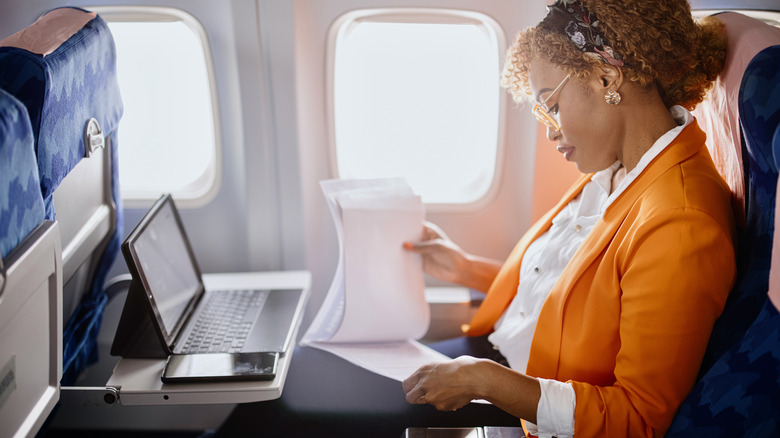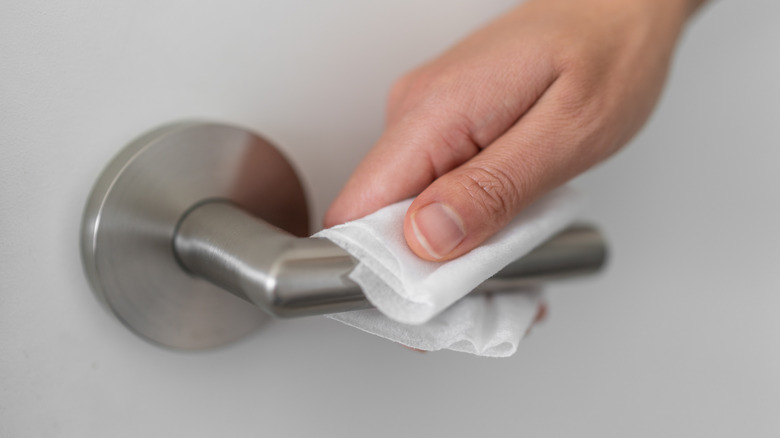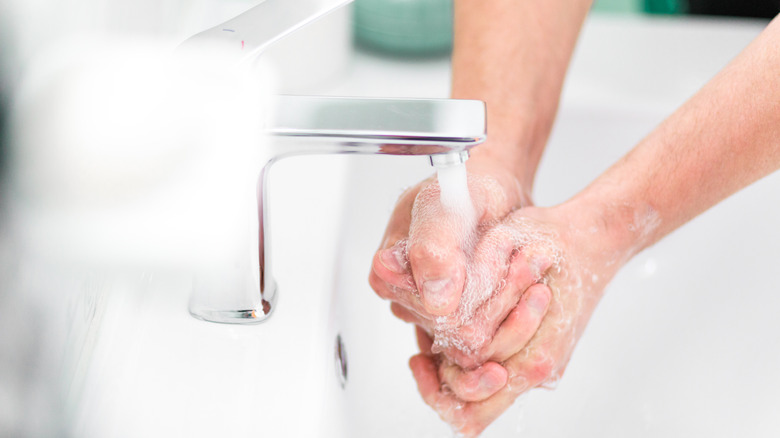A Doctor Tells Us The Germiest Spot On An Airplane & It's Not The Bathroom
Flying, whether it's across states or across countries, usually makes you want to carry some sanitizer with you. You know you'll be doing lots of sitting in airport chairs that are used by hundreds of people on any given day, and you're also going to be using public restrooms both at airports and onboard.
And if you were thinking that an airplane bathroom was the germiest spot on an airplane and planning on avoiding it at all costs (even if your flight was 12 hours long), you may want to think again, according to a study done by Marketplace, a Canadian Broadcasting Corporation (CBC) consumer watchdog news series. After analyzing more than 100 samples on 18 flights between Ottawa and Montreal, it was found that the headrest was the most contaminated place on an airplane. The seat pocket, washroom handle, tray table, and seat belt rounded up the five filthiest surfaces on a plane, respectively.
Speaking with Health Digest, Ohio State University Wexner Medical Center's infection preventionist, Kadi Banjoko, shared, "Contact with contaminated surfaces is an easy way to pick up germs from fomites. Areas such as seats, armrest, headrests, tray tables, etc. can harbor pathogens due to repeated and frequent use." Practicing good hygiene while traveling is the main way to keep yourself safe and healthy.
Disinfectant wipes could be your new best friend on airplanes
According to Banjoko, disinfectant wipes are a good way to ensure you're cleaning even the germiest spots before you come into contact with them. "Although some airlines claim they disinfect and clean after each flight, this is a fast turnover and it's possible that some areas are missed. Wipe with disinfecting wipes handles, chairs, and trays upon entering the plane," advised the infection preventionist.
Yes, there are certain things you can avoid doing when using an airplane bathroom in order to stay as clean as possible, but you can't avoid turning the handle before making your way in there, so you'll benefit from packing some disinfectant wipes with your carry-on luggage. While there might be some rules on hand sanitizers (like sealing them in a clear plastic bag for easy access through security checks), antibacterial wipes don't require such protocols. As shared by founder of AirAdvisor, Anton Radchenko (via CNN), "Wipes are great for disinfection, and they are easy to bring and dispose of."
What are some other ways in which you can practice cleanliness while traveling?
Good hand hygiene is equally important when flying
Disinfectant wipes might be a saving grace, but this doesn't mean you can skimp on hand hygiene. As explained by Banjoko, "Also, perform hand hygiene (with soap and water or hand sanitizer) before eating, after using the restroom and as necessary."
From the time you enter an airport till you check in to your hotel at your final destination, there are so many germ-filled spaces that you pass through and engage with whether you consciously realize this or not. And if you thought passing through security didn't count as one of those spots, think again.
A 2016 study by University of Nottingham experts involving Helsinki-Vantaa airport in Finland found that airport security trays (the ones you empty your laptops and phones into) were the germiest spots when it came to viruses. As Jonathan Van Tam, Professor of Health Protection from the University of Nottingham's School of Medicine, shared in a statement, "This study supports the case for improved public awareness of how viral infections spread. People can help to minimise contagion by hygienic hand washing and coughing into a hankerchief, tissue or sleeve at all times but especially in public places." Turns out, it's hard to find just one place to avoid on an airplane if you want to stay healthy. So build your best defense by paying attention to what surfaces you come into contact with and being mindful of overall hygiene.



